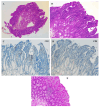Atypical Rapid Onset of Olmesartan-Induced Enteropathy with Recurrence After Rechallenging
- PMID: 40710014
- PMCID: PMC12294883
- DOI: 10.3390/diseases13070223
Atypical Rapid Onset of Olmesartan-Induced Enteropathy with Recurrence After Rechallenging
Abstract
Background: Olmesartan-induced enteropathy is a rare complication of a widely used angiotensin II receptor blocker. Patients usually present with chronic diarrhea and weight loss. Histologically, villous atrophy and intraepithelial lymphocyte infiltrates within the duodenum confirm the diagnosis. The prognosis is usually good after withdrawal of the offending drug.
Case presentation: Here, we report the case of a 76-year-old woman who developed a severe form of Olmesartan-induced enteropathy complicated by acute kidney injury and acute recurrence after drug rechallenge. After definite cessation of the drug, the patient did not experience any gastrointestinal (GI) symptom recurrence after 6 months of follow-up. However, she experienced chronic kidney disease stage G3b. Histological analysis did not show any villous atrophy or intraepithelial lymphocyte infiltrates within the duodenum or the colon biopsy.
Discussion and conclusion: This case highlights the broad spectrum of clinical manifestations and histological findings in Olmesartan-induced enteropathy. It also highlights the importance of rapid diagnosis in order to limit organ damage such as chronic kidney disease.
Keywords: acute kidney injury; diarrhea; enteropathy; olmesartan.
Conflict of interest statement
The authors declare no conflicts of interest.
Figures



Similar articles
-
Olmesartan-associated sprue-like enteropathy: a systematic review with emphasis on histopathology.Hum Pathol. 2016 Apr;50:127-34. doi: 10.1016/j.humpath.2015.12.001. Epub 2015 Dec 19. Hum Pathol. 2016. PMID: 26997446
-
Systematic review: Sprue-like enteropathy associated with olmesartan.Aliment Pharmacol Ther. 2014 Jul;40(1):16-23. doi: 10.1111/apt.12780. Epub 2014 May 7. Aliment Pharmacol Ther. 2014. PMID: 24805127
-
Interventions for central serous chorioretinopathy: a network meta-analysis.Cochrane Database Syst Rev. 2025 Jun 16;6(6):CD011841. doi: 10.1002/14651858.CD011841.pub3. Cochrane Database Syst Rev. 2025. PMID: 40522203
-
Relieving the discrimination dilemma of adult autoimmune enteropathy and common variable immunodeficiency disease: two rare causes of chronic diarrhea and small intestinal villous atrophy.Clin Rheumatol. 2025 Aug;44(8):3353-3367. doi: 10.1007/s10067-025-07523-8. Epub 2025 Jul 7. Clin Rheumatol. 2025. PMID: 40622608
-
Diagnostic Challenges in Enteropathies: A Histopathological Review.Diagnostics (Basel). 2025 Jun 13;15(12):1511. doi: 10.3390/diagnostics15121511. Diagnostics (Basel). 2025. PMID: 40564832 Free PMC article. Review.
References
Publication types
LinkOut - more resources
Full Text Sources

